Hangar No. 1 Building
1929 – Gable & Wyant
5701 West Imperial Highway – map
Declared: 11/16/66
Okay, time for a Big Orange Landmarks pop quiz!
TRUE or FALSE: Los Angeles International Airport security personnel are thrilled with and greet warmly indiscriminate trespassers snapping unauthorized photographs of key airport facilities.
If you answered FALSE, you’re wrong. The correct answer, of course, is VERY, VERY FALSE.
This hangar, the first building at Los Angeles International Airport (LAX), was finished in 1929, a few months after the airport began business on October 1, 1928. The airport at that time carried the unfortunate moniker of Mines Field, named for William Mines, the real estate guy who represented the site’s landowners.
This older shot, taken from sort of the same vantage as above, is from the city's Department of City Planning site. Are those folding doors what are called 'apronside doors' (see below)? Whatever they're called, what with all the trees there now, they haven't been used in a while.
The city of Los Angeles took full control of the airport in 1937, changing the name to Los Angeles Airport in 1941. Commercial service didn’t begin here until 1946 (Grand Central in Glendale, Burbank’s United Airport, and Van Nuys Airport all got more action back then). The ‘International’ was added in 1949.
The Spanish Colonial Revival hangar was restored in 1990 and, on 7/30/92, was listed on the National Register of Historic Places.
Hangar No. 1 is now one of three cargo buildings operated by Aviation Facilities Company, Inc. (AFCO) in what’s known as the Imperial Cargo Complex. Pulled directly from their site, here are some Hangar No. 1 specs:
- 10,497 sq.ft. cargo handling space
- 6,540 sq.ft. office space
- 25 auto parking positions
- 99’ bay width
- 114’ bay length
- 20’ to 24’ bay height
- 2 apronside doors
- 26’x18’ apronside door width and height
I know it’s a lot different than it was more than 75 years ago, but you can still get a bit of a Howard Hughesy vibe from being there.
I would’ve loved to have seen the west side of the hangar, but it’s so gated off it would’ve been tough to get to even had the two security guards there not been on me like white on rice. (Actually, they were understanding, but still ignored my picture-taking defense of, “But it’s for a blog!”)
Below is the last shot I snapped before being shooed away, and the only glimpse of the second, larger tower I've got.
Up next: Mooers House
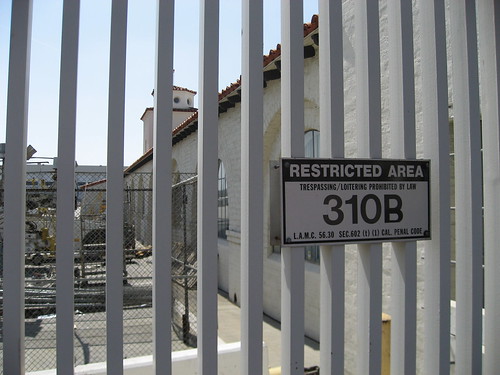
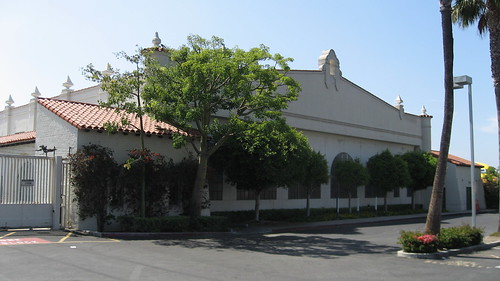
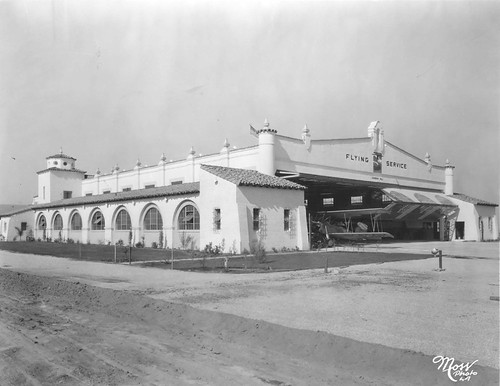

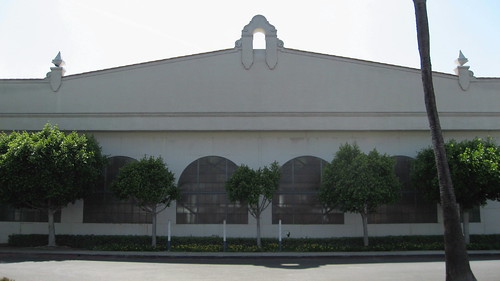
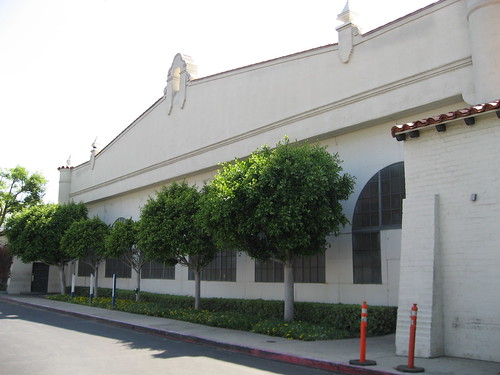


14 comments:
Just to clarify...
Ifthte building is on Airport property, which it is, then it is still owned by the City. AFCO may have a long term lease and occupy the site, but airport property is never sold.
Thanks. I've change the 'owned by' to 'operated by', which matches what AFCO reports on its site. However, AFCO does mention it's "an owner of three cargo buildings... on the south airfield". Maybe that refers to its lease?
Thanks a lot for the historical and more recent pictures of hangar #1. I was driving around LAX and noticed an old building which I thought was a church. I was intrigued given the proximity to runways and hangars and kept wondering how it got there.
Your pictures provide clarity to a curious citing in LAX.
Thanks for the comment, anonymous. As the L.A. City Nerd points out, the building's on city property. I'm thinking it should be fair game for photographing if you have the desire.
Floyd;
I would suppose that, especially post 911, nixing the photographers is more of a security thing. That way they don't take any photos of the other buildings or lay out of the airport, to use in some "bad" way.. I have seen people taking photos and the police show up and ask them to leave. But, still, good story. I'm a native Los Angeleno and appreciate such.
LAXJIM
For those that are interested Paul Freeman does an excellent site on unused and abandoned airfields all over the nation. The site has an extensive section on southern California airfields. see airfields-freeman.com
Thanks for the link, Devin.
In the extreme SW corner of LAX at Imperial Hwy & Pershing is what appears to be a rusted hulk of a plane inside an oval. You can get a good look at it on GoogleMaps or something. Why are they keeping that plane? I drove by thinking it's a museum, but noooo - all fenced and bermed off. Mysterious.
Sorry, Constance. I looked for the hull on Google Maps and couldn't spot it. I don't know its story. I give you extra credit points for using the word 'bermed', though, if that helps.
RE:Constance.
That Oval thing on the south/west side of the airport is a sewerageevaperator dish. Stuff that comes off planes that have had a health scare get dumped into the oval, the fliuds dry up and the remaining matter is tossed into an incinerator.
Sorry for the comment so long after the post, but a follow-up to the follow-up to Constance's post -- the structure that looks like a rusted out hulk in the oval at Pershing and Imperial is actually the training pit for the LAX Crash 80 ARFF (Aircraft Rescue Firefighting) unit. The rusty looking hulk is just a steel mockup that somewhat resembles an aircraft that can be ignited to simulate various aircraft crash and fire situations for training. There are several other junk airliner fuselages that can be found there on occasion that they also use for training. For photos of it in use, visit the LAX ARFF station website at: http://www.fs80.org/tour.html
Hey, thanks a lot for the comment and link, Ryan.
Floyd, Thanks for posting all the photos of Hangar 1.
I used to roam Hangar 1 when I was a kid in the 1960's/1970's. My Dad was President of Golden West Airlines, who leased Hangar 1 back then to house their DeHavilland Twin Otters. Bill Perreira originally owned GWA, and Bill was the architect that modernized LAX in the early 1960's. Dad was formerly TWA Chief Pilot at LAX in the 50's/60's and had visited Mines Field in 1929 when the Graf Zeppelin landed during its world tour. I think that leasing Hangar 1 brought my Dad "full circle" in his various careers in connection with LAX.
I always loved that old hangar. What a piece of history.
Cheers, Steve Austin
I believe that the rusted "Hull of an Aircraft" that Constance refers to is an iron airplane mock up used by the LAX Fire Department to simulate aircraft fires, so that they can repeatedly practice their fire suppression procedures. Other sections of aircraft fuselages are nearby, probably used for rescue simulations.
Post a Comment